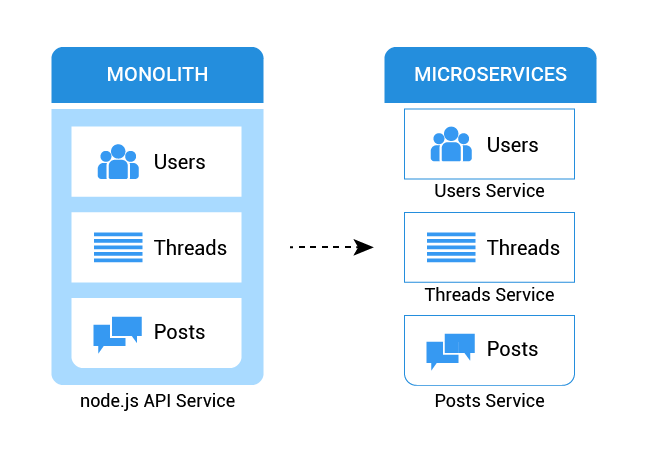In today’s disruptive web development world, microservices are receiving a lot of attention. Moreover, owning to the COIVD-19 outbreak, more and more organizations are shifting to microservices for app modernization. Due to advances in cloud technology, the demand for microservices is increasing even more in scale.
Unlike monolithic systems, microservices are designed to scale with changing market demands. So, to stay abreast, modern enterprises are moving onto microservices from legacy monolithic systems.
As per Statista’s survey, in 2021, almost 85 percent of respondents from larger organizations having more than 5000 employees are currently using microservices.
This blog post will walk you through the reasons for migrating to microservices architecture from a monolithic platform. The article also outlines a range of benefits of moving to microservices.
Why should you migrate to microservices from monolithic?
The monolithic approach makes it difficult for users to become agile as it consumes a lot of time and effort. Apart from it, there are several challenges and limitations of monolithic architecture that include:
- Lack of agility and innovation
- Impossible to scale a part of the system
- Problematic to apply new technology
- Harder to make updates/changes
- Interdependency of components
On the contrary, the microservices architecture is rapidly evolving to address these challenges of monolithic systems. As the name suggests, microservices are micros, which break up a monolith app into a set of independent services. Unlike slow and heavy monolith architectures, microservices are faster to develop and deploy. Migrating from a monolithic application to microservices also enables you to optimize resources, enhance collaboration and streamline business processes.
Microservices simplify app management, making it easier for you to build, deploy, update, test and scale each service independently. It also makes it easier to collaborate and share data amongst different teams. Likewise, there are multiple reasons to consider for migrating to microservices from monolithic, including:
Decentralized: Monolithic systems use a single database for different apps, whereas microservices have a separate database for each service. Microservices has decentralized data management and governance.
Granular scaling: You can auto-scale up or down individual services without scaling the entire app, using microservices. Thus, its simplicity improves the quality of a definite functionality.
Myriad components: You can break down microservices architecture into several component services. Then, you can independently deploy, revamp and redeploy these services.
Simple routing: The functioning of microservices is like that of UNIX systems. They have a much simpler routing process which starts from getting requests, processing them, and lastly, creating a response accordingly.
Transformative: The design of microservices architecture is evolutionary. Thus, microservices are an ideal choice for transformative systems and projects.
Failure proof: In a microservices architecture, the failure of a single module will not affect larger apps. Moreover, the design of microservices is such that it can help you cope with failure in diverse services.
These are the reasons that you must consider shifting to microservices. And to know more about how microservices can accelerate development cycles and improve productivity, read our blog post.
When should you move to microservices architecture from monolithic?
Once you have made the mind to embrace microservices, the question is – when should you move to microservices? The right time to migrate monolithic app to microservices is when your organization is growing and is facing productivity issues.
With the monolithic system, working on smaller projects is easier. However, larger projects require transitioning to microservices from the monolithic architecture. Also, when you face an issue of disrupted communication between different teams, it is the right time to make a move.
Apart from this, when the need for frequent testing arises, you must consider migrating to microservices. Many big players like Amazon, Uber, Netflix, eBay and Google have already transitioned from a monolithic architecture to microservices.
Benefits of microservices
Microservices can offer tangible real-world business benefits over monolithic, centralized applications. Let us see some of the bottom-line advantages of shifting to microservices architecture.
- Faster time-to-market
- A consistent approach to scaling
- Increased employee productivity
- Reduced application downtime
- Higher customer retention
- Easier app maintenance and debugging
- Better security of app and customer data
The evolution continues!
The microservices architecture is not new now. But it is ever-evolving with advances in the development of APIs and secure container technologies. This opens new avenues of benefits in different functional areas of a business. If your business requires migration from a monolithic architecture to microservices, get in touch with us. Our team of experts can help you make a move swiftly and take your apps to the next level.




